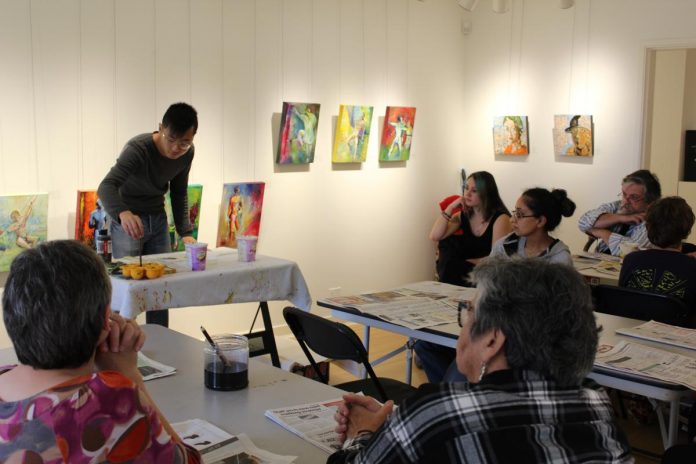On Saturday October 7, Sidi Chen taught a free course on traditional Chinese painting techniques to the public at the Kariton Art Gallery. Chen, who has been in Canada since 2014, is a visual arts student at UFV, and former president of the Visual Arts Student Association (VASA).
Attendees of the class were taught traditional methods of how to use bamboo, ink, rice paper, and fine brushes. The materials used were from China, and though you can find similar materials in Canada, Chen stated that nothing is quite the same. The paper was aged 10 years, and the brushes were very old as well. The workshop provided the chance to try out brushes and techniques, but not extensively. Participants were encouraged to take as much as possible from the demo, especially since Chen stated, “I’ve been doing this for 15 years, and I’m still learning.” Chen took the time to ask people’s names, to give respect to students before beginning. He took this as an opportunity to learn from the people who might contribute to the class.
Chen has been involved in the arts since childhood.
“My training was intense for how old I was. However, the thought of giving up never really happened in my mind. I realized later that arts had become a part of myself. It’s in my breath, heartbeat, temperature, and sleep,” he said.
With such a strong background in art, it was only natural to pursue a career in it.
“I’ve been doing it for 15 years, not only the style, but more importantly, the philosophies.”
Chen broke his presentation down into three different sections: material, technique, and philosophy.
When discussing materials, participants were taught about the integrity of rice paper, and how to properly cut it. One uses a brush and water to make a line, which can be torn, rather than using a knife or scissors. You want to use as much of its natural character as possible. Most of the time, only ink is used, though paints are popular as well. All natural pigments from stones or flowers are used to make the paints and inks. These you must be careful with, as they are very sensitive to the elements.
Chen explained how to combine all this knowledge and approach techniques. In a brushstroke, one uses the tip of the brush, then the full body, then the tip again. He demonstrated the desired transition between the paper, water, and ink. The movement is quick, but requires a lot of preplanning and practice. Empty space is used strategically to value what isn’t painted. There should be no parallel lines; too many connections are distracting, and one doesn’t normally use horizontal lines.
Chen created and passed around examples of right and wrong compositions. Another technique he explained is to paint the backside of the thin paper to create a shadow of what you painted on the front. Some people accent their work using gold leaf, or by spraying it with tea. Sometimes, when a piece is finished, an artist paints on a layer of peanut or flower oil to make the colours even more vibrant.
The group began practicing with water on newspaper before working up to ink, and then rice paper. Every attendee was given a blank sheet of the paper to take home.
The demonstration ended with a few words on the philosophy of Chinese painting: “You describe the spirituality and characteristics of something, rather than its exact image.”
He also mentioned, “There [is] a lot of knowledge that is relevant to other types of arts, and way of thinking. So, I hope this workshop will benefit in the ways that they can see.”
Chen currently has work displayed in the Kariton Gallery alongside artist Pepe Hidalgo for the exhibition “Through my Eyes,” a show about different cultural perspectives. Surrounded by his paintings at the presentation, he was able to give explanation and insight to compositional and philosophical elements of his work. He tries to combine Western styles with his tradition, and claims “Sometimes it works, sometimes it doesn’t.”
“As traditional Chinese painting uses very different materials, techniques, and philosophies, I don’t expect people can take all of them from just one workshop. However, because it is so different, I hope people can at least be inspired by one element of it, and take it back to their own practices.”


